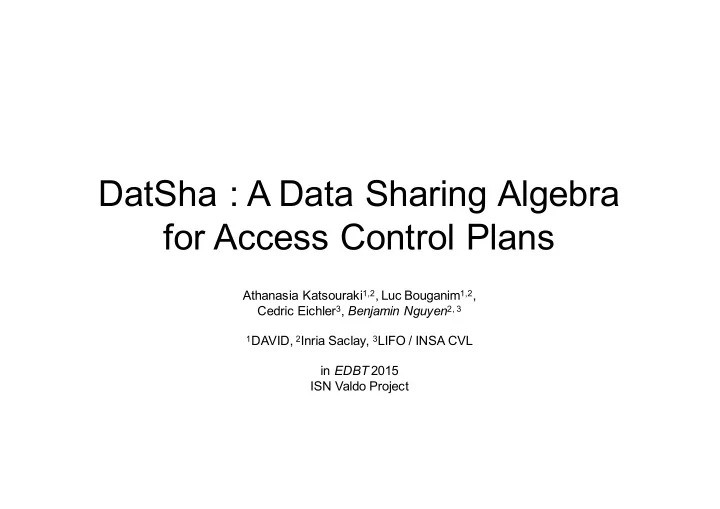

DatSha : A Data Sharing Algebra for Access Control Plans Athanasia Katsouraki 1,2 , Luc Bouganim 1,2 , Cedric Eichler 3 , Benjamin Nguyen 2, 3 1 DAVID, 2 Inria Saclay, 3 LIFO / INSA CVL in EDBT 2015 ISN Valdo Project
Context • Data sharing in Online Social Networks (OSN) is limited – Possibilities to define different circles – Publishing limited to certain circles à Difficulty to publish simultaneously to several circles with different granularities Our objective : Define an algebra to – Define Access Control Plans (ACP) – Modify, Combine, Factorise and Share ACPs à Algebra Definition à Let advanced users share their ACPs with neophyte users à Let advanced users define their ACPs with XQuery (3.0) à Let neophyte users better understand access control !! (cf AC by example) Example : Alice wants to share a set of photos with her family, photos with no metadata with her close friends, photos without faces (and without metadata) in a reduced definition with her acquaintances, and does not want to share anything with anyone else. Application : Monetize Personal Data
Another application : the ACP marketplace • Data Consumers (e.g. private companies) are interested in specific queries (e.g. relational or XQueries) • Running example : Find the most photographed place on earth. ß this intension is described by the data consumer à DC post queries and users decide (or not) to answer.
The ingredients • An AC model • The difficulty of writing AC rules • The XQuery language, and an intensional description of queries = An Access Control Plan (ACP) defined by a succession of polymorphic operators on an initial XML document.
What kind of access is given ? • Access to atomic information = a document path + an XPath • Access to an ACP • The possibility to construct a new ACP using existing access + operators (including calls to external functions). Computation of functions is assumed safe. E.g. Alice grants to bob the right to call GPS2Country(//GPSCoordinates/X, //GPSCoordinates/Y) Uses Alice’s AC rights
The ACP marketplace • Users publish ACPs (=workflows) • Creator explains the ACP • Users (maybe others comment on the ACPs + ACP intension) • Users rank ACPs = Simplify AC definition for neophyte users. à easier to understand ACPs à easier to reuse existing ACPs (if they trust ACP owner)
ACP Example Alice wants to participate in a survey to determine the most photographed place on Earth, which can be done by computing a “fuzzy” location of all her photos, where the “fuzzy” location is defined by GPS coordinates and an error bar e.g. X=45.23+/-0.01 Y=27.67+/-0.01.
ACP definition • An ACP = a sequence of operators (there is not necessarily just one linear sequence) • Operator signature (Typechecking is possible) : – Input = xml file – Output = xml file • Operator implementation – Ad hoc – XQuery 3.0 – Combination operators (e.g. n-ary join : takes n files and produces 1 output)
Operator definition The project operator, defined in the DatSha language, implemented using XPath & XUpdate
Operator Details SEE ACP.XML FILE
Impact • Simplification of the definition and combination of operators • Possibility to monetize some ACPs = pay for the results of users who execute a given ACP •
What about privacy ?? • OK to execute monetized ACPs but I want to protect my data using an anonymity model (e.g. k -anon) à Easy to compose ACPs with privacy preserving workflows (defined & scored by users)
What metadata for an ACP ? • Precise Information value • Privacy score • Anonymization and degradation schemes (both for data & pricing)
ACP modification • Due to the fact operators form an algebra, we can statically propose ACP modifications that : – Degrade (or not) the result – Improve the privacy of the computation or the result • Each user can define locally ACPs (as in virtual private DBs) that will be executed before any other ACP, or that will be executed before specific function calls • It is also possible to define global constraints (queries) that will restrict the publication of data à We want to be able to compute the quality of the result (for pri cing ) à We want to be able to compute the quality of the anonymisation (for pri vacy ) à The computation must take into account all the participants
How to correctly compute all this ? • Example : Each user has a HAVING COUNT(*) > K i condition • Reverse evaluation : – Suppose all individuals answer and remove all data that does not respect the conditions – Iterate until fixedpoint is reached – Works if : monotonicity (condition must stay false when tuples are removed)
How to securely compute all this ? Use Trusted Cells paradigm J (See previous SMIS presentations)
Open questions • Data & query pricing • Risk evaluation • ACP optimisation • Multi-criteria optimization (data + privacy)
Questions ?
Recommend
More recommend